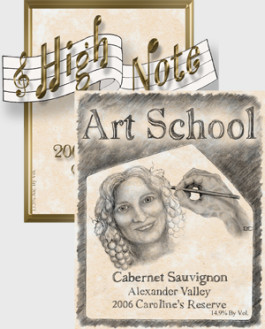Metaphors In Wine Journalism.
Chapter Six, Part Three.
 Are you feeling some trepidation about your ability to accurately evaluate and describe wine? Relax. Wine analysis isn’t black arts or brain surgery … It’s rocket science. Hey, I’m kidding. Describing wine is easy. All you need is a steady stream of euphemisms, metaphors and dialysis treatments.
Are you feeling some trepidation about your ability to accurately evaluate and describe wine? Relax. Wine analysis isn’t black arts or brain surgery … It’s rocket science. Hey, I’m kidding. Describing wine is easy. All you need is a steady stream of euphemisms, metaphors and dialysis treatments.
If you’ve been following these pages you should now be adept at euphemisms and similes so it’s time to let the right brain step up to the plate and take a swing at metaphors. Wine writers use a truckload of metaphors, or maybe it’s a ton of metaphors … no, it’s a sea of … you get the idea, we use lots of metaphors.
Some are so commonplace that they now blend into the vocabulary of wine and we no longer recognize them as metaphors. You may hear wines described as soft or hard, wimpy or muscular, elegant or powerful, paper or plastic.
There are all kinds of metaphors. We have artsy metaphors, you know the ones, they sound like they were written by a Victorian roustabout rather than a wine critic. These devices may seem more poetic than descriptive, but wine has been known to rouse the sleeping poet in many of us and I’m betting that after reading the following examples you’ll feel it’s wiser to let sleeping poets lay.
On an unoaked Monterey Chardonnay label I once wrote, “… it’s Van Gogh’s vivid Sunflowers in a glass”. I proclaimed the Reserve Chardonnay was, “a Sunday stroll through a fine art museum”. I know this sounds like tartaric wasn’t the only kind of acid in my wine, but these metaphors seemed appropriate for a label I designed called Art School, or at least I thought so after drinking both bottles.
 Musical metaphors are also very popular with wineries. In fact, many wineries use musical terms as metaphorical names for their wines. High Note, Adagio, Symphony, Arietta, Allegro, Étude, and Magnificat are all musical terms as well as wine names. I went on a musical metaphor binge when I wrote the tasting notes for a commercial wine label I designed called High Note. I deemed the Cabernet Sauvignon “a fine symphony, beautifully orchestrated and building to a full-bodied crescendo.” The Syrah possessed the “resonant force of an open fifth power chord in a heavy metal rock anthem”. After 20 years in the liquor trade it’s safe to say I know a thing or two about open fifths.
Musical metaphors are also very popular with wineries. In fact, many wineries use musical terms as metaphorical names for their wines. High Note, Adagio, Symphony, Arietta, Allegro, Étude, and Magnificat are all musical terms as well as wine names. I went on a musical metaphor binge when I wrote the tasting notes for a commercial wine label I designed called High Note. I deemed the Cabernet Sauvignon “a fine symphony, beautifully orchestrated and building to a full-bodied crescendo.” The Syrah possessed the “resonant force of an open fifth power chord in a heavy metal rock anthem”. After 20 years in the liquor trade it’s safe to say I know a thing or two about open fifths.
Blended wines, those wines mixed from several different grape types, have their own category of metaphors. I speak of course, of mixed metaphors. If you encounter a mixed wine with perplexing flavors and aromas, have some fun and use a befuddling mixed metaphor in your description. You may find a Cote Rôtie (a unique blend of red and white grapes) has aromas that hit the bull’s eye, but the flavors strike out. A Bordeaux (another blended wine) might parry and thrust across your palate before crash landing in the finish. You might even discover a wine that misses the boat because the sweetness hits your palate like a ton of brix.
You know nothing pops my cork quite like sexy metaphors. Wine critics seem to possess an inexhaustible supply of libidinal metaphors and their reviews can stimulate more than your taste buds. Who could resist a voluptuous Viognier, a seductive Chardonnay, or a hedonistic Hermitage? What’s not to like about a sinuous, full-bodied wine that is supple and fleshy, with long legs, a luscious attack, and a lengthy, succulent finish?
These sexy reviews have been known to confuse and excite some winemakers, leading them to premature inoculation.























Re “…sweetness hits your palate like a ton of brix.” You’ve misspelled BRICKS…Oh…I get it…never mind!
It takes a lot of brix to fill a tun. I guess I should have saved that one for the upcoming post about puns.